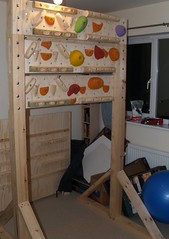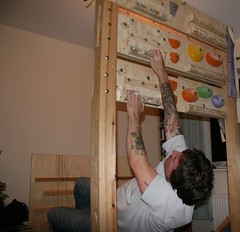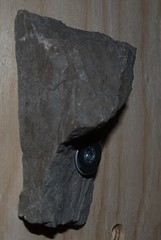The OCD world of Andy’s climbing training
First, what the heck is a woodie and how on earth can it help with climbing? A woodie is best described as a freestanding frame that facilitates a wide range of training techniques. These go beyond pull-ups which many people wrongly assume is a woodie’s primary and only function.
It is designed for tendon-friendly muscle-strengthening endurance exercises. These target the fingers, arms and back. It will work these areas in a similar way to as if the climber were on steep rock, and is therefore an ideal training medium if your aspirations are for climbing in this direction.
What it will not do is improve your footwork, unfortunately, you’ll still have to go to the rock-gym or, heaven forbid, climb real rock to achieve this.
The aim is to build up to being able to complete burns of between 4 to 10 minutes separated by 10 to 15 minute breaks. Depending on how you attack the workout session, you can work your aerobic endurance and/or gradually push your anaerobic threshold further. What this does aerobically is to increase your endurance and thusly increase the time taken before the dreaded anaerobic pump sets in. However by using this device you can hang in there once the pump sets in and see how far you can push it in a fairly safe environment, crash matting is advised. I have commandeered Caroline’s boulder mat for this purpose.
Once you start to get a feeling for just how long you can actually “hang-on” once pumped, when you’re on real rock you will see a decrease in the panic / stress that can accompany this sensation.
In short, a woodie can be used to develop endurance and strength in the upper body, especially the forearms and fingers. It is not used to develop power.
Advantages:
- It is free standing, hence no need to rebuild your house (important if you are renting and prefer not incur the wrath of your landlord).
- It is relatively cheap; you can keep the cost down by making your own wooden holds.
- It requires only basic woodworking skills and tools.
- It can be built well within a single weekend (ideal winter project).
- It is relatively small so should fit into a spare room.
- As it is in the house and not a cold garage, you are more likely to actually use it.
- It is very versatile and can be used for a great many exercises.
Materials required:
- Two 7-foot 4x4s; kiln dried (if you weigh less than160 pounds these can be reduced to 2x4s). These are used for the vertical supports.
- A minimum of two pieces of ¾-inch plywood are used for the horizontal cross members. These are sized (minimum) of 8 x 42 inches, mine were longer as I was making a custom version, as opposed to the standard one that is shown in Eric Horst’s book Flash Training. It was this book that inspired me to build my own woodie.
- Two 48-inch 2×4’s, these are attached to the vertical 4x4s to stabilise the unit.
- Four 31-inch 2x4s. These are used to support the vertical 4x4s to the bottom stabilising beams.
- Four 90 degree Teco (or similar) plates to secure the vertical units to the lower stabilising parts (easy) or if you are more skilled use a mortise & tenon joint with two coach bolts per side.
- Fixings: approximately 25 3-inch drywall screws (wood-to-wood joins), 25 1.5-inch drywall screws (Teco plate to wood joins) or use coach bolts long enough to run through 4 inches of wood.
- Finally, T-nuts and fixings.
 |
 |
 |
 |
The woodie could be made narrower to hold just a fingerboard if you’re quite pushed for space. Anyone wanting to make one who would like further advice or assistance, I’m only an email / phone call away.
Sources / Further reading:
Horst. E. J., (1996), How to Rock Climb: Flash Training, Chockstone Press
The above book is out of print but is readily available on Amazon, or mine is available for a short term loan.
